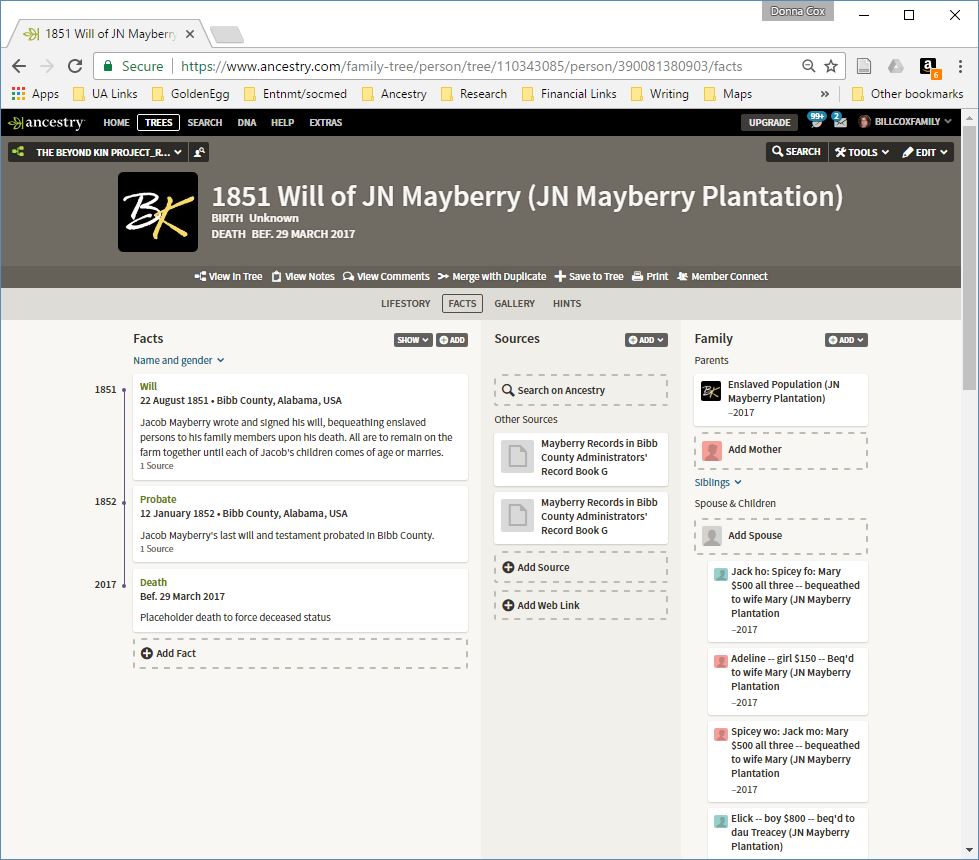To be successful, the Beyond Kin Project requires a method for documenting slaveholder (SH)/enslaved person (EP) connections with existing software tools and the ability to share data. The more consistently we all document our ancestors’ “Beyond Kin” — those whose lives were intricately intertwined without being genetic or legally kin — the more easily we can interpret and share what we find in each other’s trees.

The Beyond Kin Project is not the first voice to cry out for better documentation of our EPs, of course. Many have pondered the need. But we all soon recognize that the various software packages we use are not designed for this. Our first discovery of an EP often offers only an information fragment without even a name. Using our software as designed, a person without known family connections becomes a floating head, difficult to ever relocate in a tree of hundreds or thousands.
Fortunately, we have developed a method to work around the design. It should work with most popular genealogical online trees or desktop software packages, assuming they allow multiple marriages and unlimited children to a marriage. (See The Beyond Kin Project and FamilySearch for a note about incompatibility with this one environment.)
The Beyond Kin method allows EPs to be gathered together and loosely connected to the SH’s family record. It also eliminates the “floating head” problem. This way, as you begin to fill in details on each person, you are creating a record in a form we all recognize. And we can share this record with others by GEDCOM.
Until a better software option appears (see our software enhancement proposal), we are using placeholder “spouses” to link the Beyond Kin. This allows us to draw a group of people from different families into a group, sharing a story, based on their nonbiological ties. The method includes naming conventions for optimal effectiveness and creates the links in such a way that EPs will not appear to be the stepchildren of their SHs.
While not as elegant as a built-in software solution, this workaround offers a tremendously easier method than attempting to study the EPs outside of our familiar tree applications. Until our software developers modify their applications to handle Beyond Kin links (and agree together to do it in a way that allows GEDCOM transfer), we can do the most good by sharing this common method.
To study the Beyond Kin method in action, you can explore our prototype tree called “The Beyond Kin Project.” The project works outward from slaveholder Jacob Newell Mayberry (b. 1786).
To view it in Ancestry.com, go to The Jacob Newell Mayberry Prototype on Ancestry.com. Look for a second spouse called “The Beyond Kin Project,” and then look for this spouse’s spouse called “Enslaved Population.” This spouse has “children,” each one a source record (such as a census or will) in which EPs have been mentioned. Go into one of these “source children” to see the EPs.
Bear with us. This will all start to make sense as you go. We also have an online forum where we work through special circumstances and ask each other questions. Join us at The Beyond Kin Project Forum on Facebook.
Let’s get started
Read each of these three topics, in this order, to walk through the process. These topics are also listed in the menu to the right.
For instructions in African American genealogical research methods, see Making the slave connection: an introduction.
Sign up to receive notices of new developments in the project. We will not share your email address outside our team.

